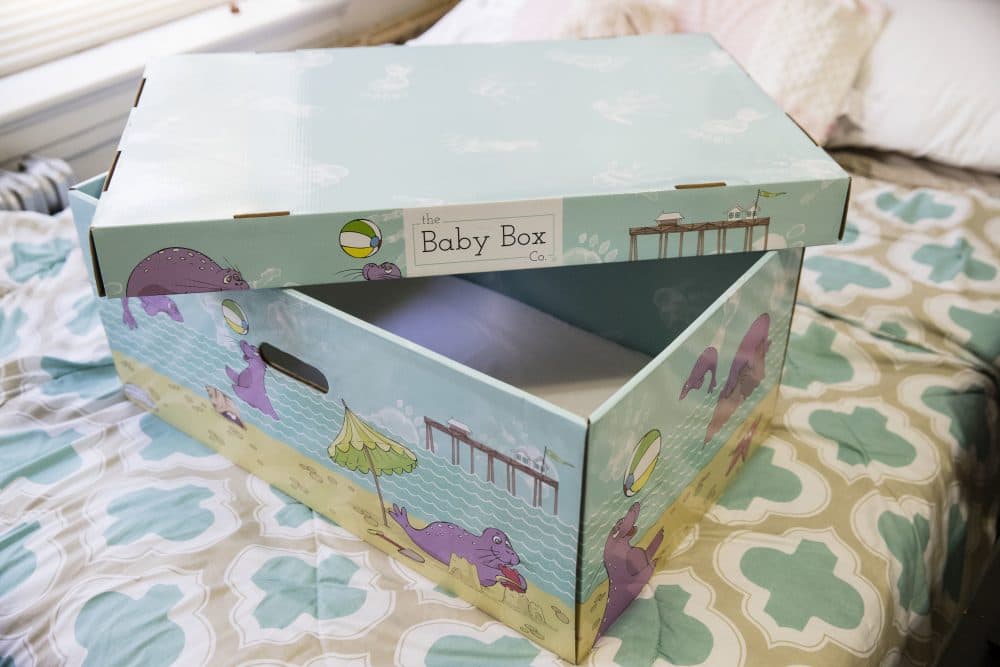Advertisement
Can Cardboard Boxes Save Infants' Lives?
Resume
Since January, about 3,800 New Jersey parents have opted to lay their infants to sleep in simple cardboard boxes. It’s a public health initiative to reduce cases of sudden infant death syndrome, which killed 3,700 babies in the United States in 2015.
Dr. Kathryn McCans is a pediatrician at Cooper University Health Care in Camden, New Jersey, and the chair of the New Jersey Child Fatality and Near Fatality Review Board. She joins Here & Now's Robin Young to discuss the project.
Interview Highlights
On how the box compares to a crib
"It is not safer than a crib, that is meeting all the recommendations for safe sleep. This program is really meant to decrease what we call SUID deaths, which is sudden unexpected infant deaths. Those deaths are comprised of SIDS, plus a number of causes of sleep-related death that are impacted by the environment the baby's in. So these deaths can include accidental overlying when the baby's sharing a surface with another person, suffocation when they get trapped under blankets or in pillows, strangulation if something wraps around the baby's neck, entrapment when the baby gets stuck between a poorly fitted mattress, or cushion in some other surface that's part of their sleep environment."
On the New Jersey Baby Box Initiative's goals
"What we are trying to promote is a safe sleep environment, and parents adhering to all the recommendations that decrease the risk for SIDS and SUIDS. And we make our cribs look beautiful for our babies, because we think that's gonna be a benefit to them. But the reality is that you don't want any pillows, bumpers, blankets, stuffed animals in the crib with them. You don't need any additional layers underneath the crib sheet, between the crib sheet and the mattress — all of those can contribute to unsafe sleep. But we can make other choices like providing a tobacco-free environment, prenatally and postnatally. That is a big contributor to decreased SIDS risk, ensuring that mothers have prenatal care, that mothers breastfeed exclusively for the first six months, but any breastfeeding is protective against SIDS, in particular.
"So there's a list of recommendations that has been put out by the American Academy of Pediatrics Task Force that talks about all the things we can do. We recommend that infants sleep in the room with the parent, but not on the same surface. So falling asleep on a couch with an infant is a particular hazard. It is higher risk than falling asleep in a bed with a baby. And this effort to decrease SIDS and infant- and sleep-related deaths really started with the Back To Sleep campaign in the 1990s, and that dramatically decreased the incidence of SIDS. People don't make the choice because sometimes they don't know, or frequently, they don't know all of this information."
On educating parents about how babies should sleep
"A baby needs to go to sleep on their back, every time. It's a particular risk for a baby if they are mostly put to sleep on their back, and then an alternative caretaker puts them to sleep on their belly. That actually increases a baby's risk. But, for our program in New Jersey, it's about, in order to get your box for free, you need to do the education. And it's inexpensive, so there should be no barrier for someone obtaining this. And we anticipate as many as 105,000 baby boxes to be given out in New Jersey this year, based on predicted birth rate. It's the cost of the box that allows us to do the program.
"One of the nice things about the box is that it's portable, it makes an ability to take the box and put it next to the parents' bed, or bring it down to the living surface and prevent a child from being put to sleep on their, say, on a sofa or something like that. You could take it with you to the family barbecue, or when you travel. That's, to me, one of the assets of the box — you can find lots of things on the market that people are selling that frankly have been proven to be unsafe. So these positioners for babies, they aren't safe — babies need to sleep on their back. So using a positioner device to keep them on their side, is not recommended. Baby monitors do not increase babies' safety from a sleep perspective."
This article was originally published on March 23, 2017.
This segment aired on March 23, 2017.